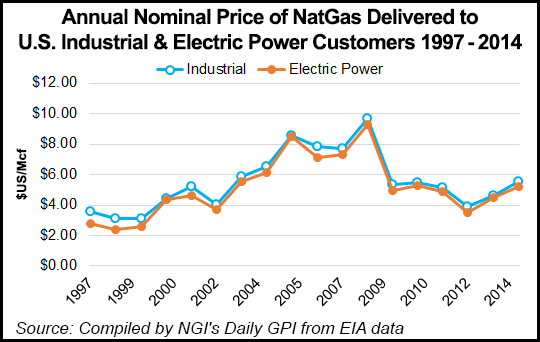Infrastructure | NGI All News Access | NGI The Weekly Gas Market Report
AGA Sees More Burner Tip Cheer This Winter
Robust production, high storage levels and increasing efficiencies will make for residential natural gas bills that are 5-7% lower this winter than last, the American Gas Association (AGA) said. The cheapest home heating option is now even cheaper, according to the organization representing natural gas utilities.

“Abundant supplies, reasonable temperatures and a moderate increase in total U.S. demand may result in residential natural gas bills lower compared to last year,” said Bruce McDowell, AGA managing director of policy analysis. “This winter, many Americans on average may see the second-lowest bills they’ve seen in the past decade.”
The direct use of natural gas continues to be the most affordable energy option for home heating and offers lower greenhouse gas emissions than other home energy sources, AGA said.
AGA’s outlook is in line with that of fellow trade organization Natural Gas Supply Association of America (NGSA). Expectations for a mild winter combined with strong production, robust storage and an anticipated small decrease in overall demand mean this winter will be “neutral” for pressure on gas prices, NGSA said last month (see Daily GPI, Sept. 30).
“The production of natural gas through its delivery into buildings is more efficient than grid-delivered electricity, propane, or oil,” AGA said. “Even as more renewable sources are added to our nation’s electric generation mix, the direct use of natural gas will remain an efficient, affordable, and low-carbon option for consumers.”
Continued modernization of midstream infrastructure means natural gas will only become a cleaner and less expensive option for home heating in the future, according to AGA.
“As our nation continues to modernize the natural gas pipeline network and connect more homes and businesses to this system, new opportunities arise to achieve low-cost carbon emissions reductions by leveraging this existing infrastructure and the nation’s abundant natural gas resources,” said AGA’s Richard Meyer, manager of policy analysis. “Gas utility efficiency portfolios, conversion programs, consumer education campaigns, and other efforts may be leveraged to count emissions reductions that are consistent with broader federal, state and local environmental goals currently under consideration, such as the EPA Clean Power Plan.”
Last month, AGA said that the residential and small commercial markets would continue to be growth areas for gas demand (see Daily GPI, Sept. 22). The number of homes and businesses using natural gas has grown steadily for decades, AGA said. There were fewer than 40 million residential gas customers in 1970, a number that ballooned to more than 60 million in 2013.
© 2024 Natural Gas Intelligence. All rights reserved.
ISSN © 1532-1231 | ISSN © 2577-9877 | ISSN © 1532-1266 |
